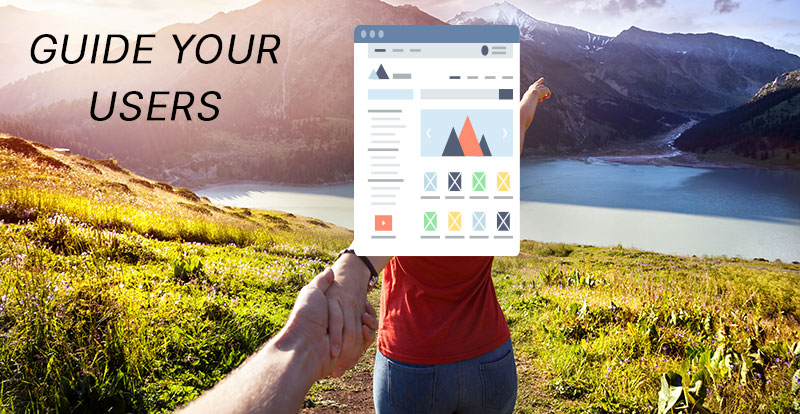It’s not existential or spiritual (my favorite kind), but customers undergo a journey when they buy your product. It’s not some guru-based way of describing businesses, it’s a carefully laid set of steps that takes a customer from the need for a product to using it. The best businesses don’t rely on that journey naturally leading to their product, they create their own path and, hopefully, guide their customers down it. Your website isn’t just a step on that journey, it could be the entire thing. If you’re not using every resource your website has to offer, you’re failing to create a customer journey that’s guaranteed to help conversion and sales.
Your website is a tool, but it’s also a platform. It can be its own form of social media, its own storefront, and its own showroom and gallery. Your website is integral to every single step in the customer’s journey, whether you know it or not. Before I explain how you can integrate the customer’s journey into your website, let’s talk about that journey.
Creating a “Map”
The customer’s journey can ultimately be organic, but it shouldn’t be. When they have a need, research a way to resolve it, then buy and use that resolution they are ultimately completing a customer journey. In case you missed it, that customer didn’t need a website to complete that specific journey. That’s why businesses need to create maps that do the guiding for the customer.
To know your consumer, define the way they get to know you. If your business offers a product or service that addresses a pain point, or improves quality of life, you know what your market is looking for when they find you. While every industry has its own unique map, they all feature the same basic bones, and the very first step is always awareness.
Awareness
- Traffic, users, and customers need to be aware of your business before they’ll use it.
- Brand recognition, social media, and search engine results are the central pillars of this step.
- This is when your customers are educated on your business, ensuring they learn everything they need to know to build trust.
Reputation
- That trust turns into a business reputation.
- Establishing authority is important for any industry, be it from social proof or accolades or anything else that demonstrates knowledge and capability.
- Customers want to know they’re making the right choice, give them everything they need to make an informed decision.
Conversion
- It’s time for the customer to make a choice, and you want that choice to be a buying decision for your product or service.
- This is the persuasion and decision stage, where the customer needs to be given every opportunity to convert so that they do.
- Pricing, guarantees, offers - give the shoppers and customers every bit of information they’ll want to know.
Usage
- An informed customer is one who also knows how they’ll get the product, how to operate it, and how to continually use it.
- Continued usage instills confidence in your brand, helping to attract new customers as buyers create social proof for their purchase. Sometimes with use alone.
Retention
- After the buyer concludes the rest of the customer journey successfully, you’ll want to retain that client. Continued business means continued revenue, and it’s the second most important part of the journey after awareness.
- A happy buyer will continue to buy and use your product, do everything you can to encourage and retain loyal customers and they’ll reward you in turn.
- Referral bonuses and unique offers can foster loyalty in your customers, which then spreads as they become vocal advocates of the business.
Those steps aren’t new aspects of the consumer process. Actually, commerce has existed the same way for thousands of years. The only difference is your website can now be an integral part of every step of the customer journey. Here’s how.
Educate the Customer
Awareness and Reputation can both be established by your website. When a customer searches for a product or service in your industry they need to be seeing your website. That doesn’t mean you need to shell out expensive ad buys on Google, it means you need to use your website so that it educates your customer on your brand.
SEO tools that help with keyword research will create organic awareness in your business. When customers search for a solution, or for similar products, they’ll find you thanks to those same searched keywords being present on your web page.
Once they find that site, your social proof or certifications can establish your reputation. Testimonials from happy customers are one of the most effective means of convincing a user to become a consumer, so make sure they’re front and center on your landing pages.
Guide the Customer
Once that user is educated about you, it’s time to turn them into a customer. Websites are possibly the greatest innovation in the history of conversion. Again, not a new practice considering shop owners have been trying to convince passersby to become customers for thousands of years, but a website can do so much more.
Your customer will always have questions, even after becoming aware of your business. Your website’s content and design can answer everyone one of them. Informative blogs with targeted content can establish your authority and increase sales. Guarantees and offers can create confidence in purchases. Then, chat boxes or contact forms can put unsure users in direct contact with your sales department to help them make an informed decision. Once that user has made that sale, your website can also help with usage.
For businesses looking to cultivate loyalty and even community, they can offer chat forums or detailed tutorials that educate the customer on how to use their new service or product. That also helps with retention too. Customers want to know about innovations or potential upgrades. They want to proudly rep your brand and business, and your website should give them every opportunity to do so.
Keep them informed about new products or advances with basic email marketing. Create events, even virtual ones, that offer insight or Q&A opportunities. The consumer wants to know they’re being heard, so literally listen to them and you’ll earn that loyalty and that repeat purchase.
Your website isn’t your business, but it can be one of the foundational pillars keeping that business up. E-commerce sales were almost 15% of all sales in 2022, so it’s time to recognize the importance of your website, even if it’s not as successful as your storefront. It’s not just a home for the “Add to Cart” button, it’s the road by which thousands of users could learn about your business. Make sure they’re doing more than learning by creating a competent customer journey that is mapped entirely through your website.



